Driving Concussed
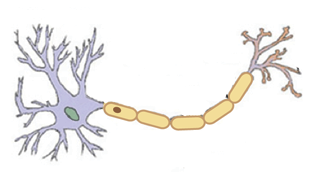 This week brings the return of Jeff Gordon to the track, but under conditions I’m sure all of us wish were otherwise. Dale Earnhardt, Jr. is out again (and will be next week) with “concussion-like” symptoms.
This week brings the return of Jeff Gordon to the track, but under conditions I’m sure all of us wish were otherwise. Dale Earnhardt, Jr. is out again (and will be next week) with “concussion-like” symptoms.Concussion, like many medical problems, is a chronic injury — meaning that it can continue to play a role in your health, even after you’ve mostly recovered from it — as anyone who’s broken a bone that flares up when the weather changes knows.
Junior has had a number of previous (diagnosed) concussions. Add to that a rough 2016 season and you’ve got a recipe for problems.
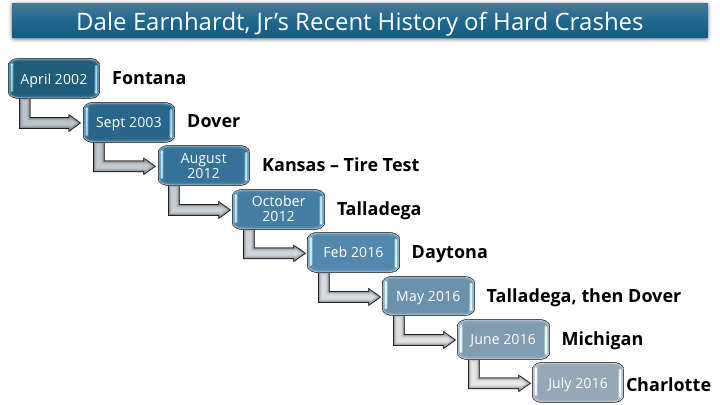
One of the issues is that we didn’t understand concussions at all fifteen years ago. I spoke with a leading expert three years ago and he said that 90% of what we know about concussions we’ve learned in the last ten years. So when Junior had a concussion back in 2002, no one knew how to treat it properly. And the chart above doesn’t mention the times where there might have been a concussion that wasn’t diagnosed.
Junior mentioned that his reaction to the last hits at Michigan and Charlotte told him that something was not quite right with his body. He’s been having balance and nausea issues since Kentucky and took himself out of the car last week at New Hampshire. Everyone’s been saying it, but kudos to Junior for taking himself out of the car and having the courage to deal with this challenge so that his long-term health is the primary concern, not his driving career.
The Amazing Floating Brain

I’ve written in detail about what happens during a concussion and there are links to previous blogs on this topic at the end that are worth checking out. The thing a lot people seem to miss about concussions is that the blow to the head that starts the process isn’t the issue. The problem is that your brain is not rigidly attached to your skull.
As you can see on the diagram at left, your brain is tethered by your spinal cord, but there are no points of attachment between the brain itself and the skull.
That’s sort of important because if your brain were rigidly attached to your skull, your spinal cord is what would give in the event of a force to the head and that would be fatal. So the brain floats in the skull, cushioned by the cerebrospinal fluid. Your body is constantly making and absorbing this fluid.
Here’s an interesting side note: Hippocrates (circa 400 BC) and Galen (circa 150 AD) both mentioned the cerebro spinal fluid in their writings. Then it disappeared for the next 16 centuries. It turns out that the prevailing method of autopsy during those times was to start by removing the head from the body, so the fluid all leaked out and when they got around to cutting open the head, it had all leaked out! I mention this because sometimes “scientific progress”… isn’t actually progress.
If you were going to model the brain and the skull, put an egg in a glass jar that just fits it. Fill the jar with water and carry it around. With gentle jostling, the water protects the egg. Now take it in the car, drive 30 mph and slam on the brakes. The water isn’t going to protect the poor egg when it slams into the glass jar.
Well, that’s exactly what happens to your brain in a concussion. The brain (the egg) slams into the skull (the jar) hard enough to damage it.
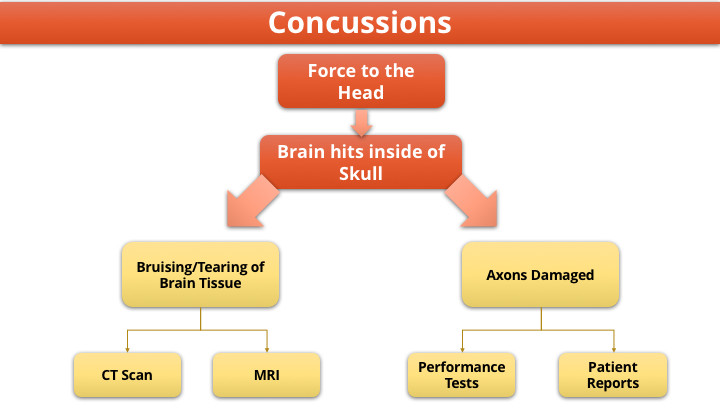
Using our analogy of the egg in the mason jar, you can have an event that doesn’t do any damage to the jar, but cracks the egg. Even a low-g crash that looks like nothing can cause a concussion.
Any damage to the brain is called Traumatic Brain Injury (TBI), although the magnitude of the injury can range from almost nothing to bleeding and internal damage that results in death.
There are two general types of damage to the brain
- Bruising or tearing of the brain tissue, which may include bleeding and swelling
- Damage to axons (the nerve fibers that make up the brains ‘wiring’)
The first of these can be catastrophic, as your brain can swell. Since the skull is rigid, the brain has nowhere to expand. The tissue gets compressed and can die. We have some very good techniques (CT Scan and MRI) for identifying areas where the brain may be bruised, torn or bleeding.
Detecting damage to the brain’s wiring is much more difficult. Patient reporting is suspect. Sometimes, patients don’t want to be diagnosed and thus minimize or hide symptoms. But even when a patient is being as honest as possible, the nature of the injury is such that it can make it hard for them to know. If they say they’re dizzy, it’s nothing like getting a picture of the brain and being to evaluate that.
An example of a performance test is the ImPACT test NASCAR has adopted as their standard. They require the person to complete a series of quick mental tests that are designed to determine what type of impairment may exist — if any. A baseline is measured so that there’s comparison available between the person’s normal state and any impairment can be determined.
Why Not Drive Concussed?
Junior has said he’s had problems with balance and nausea. That’s not surprising because the same mechanisms responsible for balance also cause you to feel barfy. Your inner ear controls your balance. Even without damage to the ear, a concussion can cause problems with how the brain interprets the signals the ear is sending. (Disclaimers: I’m not a doctor and I’m not trying to diagnose Junior. I’m just trying to make the point that since everything you experience is processed by the brain, a concussion can impact almost any aspect of your experiences from hearing and sight to motor skills
It’s obvious, right? Someone feeling dizzy should not be on a racetrack going 180 mph. He’s a danger to himself and everyone else on the track. But even if the dizzy spells go away, there is cause to be concerned about driving while concussed.
If you take one thing away from this blog, it should be this:
Something already damaged can be damaged more easily — and the subsequent damage can happen more easily and be more serious.
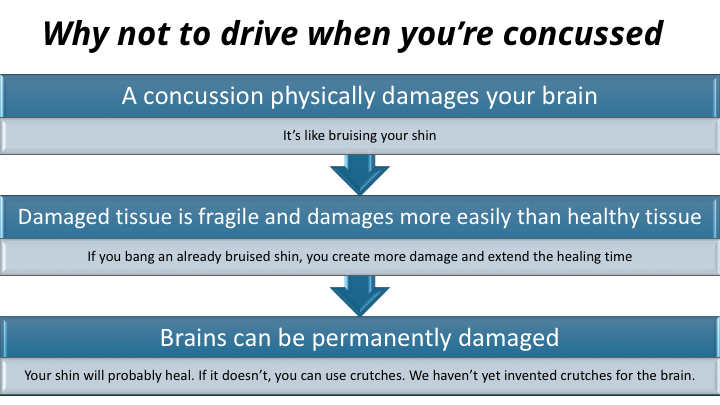
Someone suffering from a concussion is risking their long-term health by taking a chance on re-injuring an already injured brain. I have a good friend who is dealing with a neurodegenerative disease and it is absolutely heartbreaking to watch someone lose their cognitive abilities and their capacity to take care of themselves.
The Latest in Diagnosis and Prevention
If you get cancer, doctors run tests and can give you a pretty firm diagnosis: you’ve for Stage 1 breast cancer, for example, or Stage 4 pancreatic cancer.
There is nothing comparable for most issues that affect the brain, from Alzheimer’s Disease to dementia to traumatic brain injury.
We can use CT scans (which are basically 3D x-rays) and MRI to detect physical changes to the brain. CT Scans measure differences in density. Since we know how dense your organs should be, we can tell when there’s something out of whack. A CT scan can reveal physical changes in the brain: hematoma (bleeding within and surrounding the brain) and swelling.
But it’s entirely possible for a patient with a concussion (or even a more serious Traumatic Brain Injury) to have a perfectly normal CT scan.
You are Nuclear
Don’t go getting all big headed. Everyone is.
And it’s a good thing, otherwise MRIs wouldn’t work.
MRI stands for Magnetic Resonance Imaging. Physicists (the folks who invented it, you’re welcome) developed it as Nuclear Magnetic Resonance, but people freak out when you use the world “nuclear”, so they changed the name because apparently people are sooo freaked out by the word that they don’t listen to the explanation and assume you are bombarding them with mysterious ray from nuclear waste.
It’s not complicated. What’s nuclear about you are the nuclei in every single atom that makes up your body. Since most of the human body is water, most of the nuclei in your body are water. Water molecules have one oxygen molecule and two hydrogen molecules, which means you have a heck of a lot of hydrogen nuclei running around your body.
Each nucleus is made up of protons and neutrons. (Yes! You carry neutrons around with you, too!)
Protons are magnetic. (Neutrons are not, but they aren’t too upset because, hey, did the Pointer Sisters ever record a Proton Dance song? No.) But I digress.
Protons are magnetic like a compass needle — except it takes a honkin’ big magnet to move the spins in a proton.
The strength of a typical refrigerator magnet is about 5 milliTesla. The strength of a magnet in a MRI is about a thousand times bigger than that.
This is why, when you go for a MRI, they tell you to leave your wallet — and everything else — outside. A MRI magnet will not only wipe out your credit cards, it will pull a screwdriver right out of your hand. Yes. I have personally had this happen to me in a lab when I forgot a magnet was on and went in to adjust something.
A MRI uses this giant magnetic field to align the protons, then it smacks them with a radio-frequency wave, knocking all the spins down. But since the field is still there, the protons get up again. As they get up, they give off energy. We measure that energy and it tells us something about the environment the protons are in, which lets us distinguish a liver from a kidney, for example.
You can use MRI for imaging the same way you use a CT scan. The arrows in the picture below shows small hemorrhages in a brain, for example.

But even this type of MRI cannot detect damage to axons. So it is again possible to have a concussion and a totally normal MRI scan. But there are some developing techniques that may be able to offer us indirect evidence of neuronal impairment.
fMRI
The f is for Functional. Why it is not capitalized, I don’t know. It’s “functional” because it doesn’t look at structure like regular MRI does. It actually images how your brain changes when you think or move (or do anything)
Whenever your brain does something (i.e. whenever you do something), more blood flows to the parts of your brain engaged in the thought process because the cells need oxygen. The harder they work, the more oxygen then need.
We know that different parts of the brain are responsible for different functions. For example, hearing and sight are primarily processed in different parts of the brain. We’ve know about rough divisions for some time, but we’re still learning. In fact, the New York Times has an article this week about scientists having found another hundred specialized areas of the brain. They haven’t found the part of the brain that controls what a driver says in the thirty seconds after he gets out of a race car that’s just been crashed — but I think that’s because it doesn’t exist.
You can tell when you’re looking at a fMRI image compared to a regular image because regular MRI is usually shown in black and white like an x-ray. fMRI is superposed over a structural (regular) MRI and looks like someone took the MRI pictures and painted it with day-glo colors.
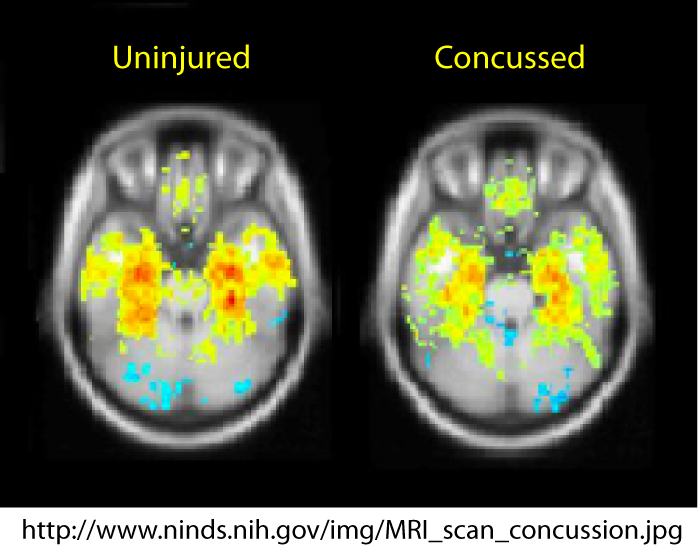
This image (from researchers at Penn State) compares the resting state MRIfor two patients, one concussed and the other not. As usual, we use the rainbow scale (ROYGBIV), so red means lots of blood flow, blue means not as much. You can see that there is not only reduced blood flow overall in the concussed patient, but there are also some different parts of the brain “lit up”.
The good thing about this technique is that you can see a really graphic difference. The bad thing is that the technique is in its infancy and we’re not totally certain what those differences mean. You will find people who treat it like a magic box and purport to tell you everything from propensity to dementia to mental health state. Maybe someday, but for now, it’s a relatively simple test to perform that is profoundly complicated to interpret.
For example, a damaged brain can sometimes rewire itself. The brain automatically figures out how to re-route incoming signals to parts of the brain that work. We have almost no understanding of that process. But what it means for concussion is that even if you aren’t having any symptoms, there may have been permanent, possibly irreversible changes to your brain.
We are, unfortunately, a long way from a situation in which a driver can go in for a fMRI and be told “another week and you can drive without jeopardizing your long-term future.
How Do We Stop Concussions?
Ideally, we wouldn’t worry about developing ways to treat concussion. We’d figure out how to stop them from happening in the first place. The big problem is that Stopping the head isn’t enough when we’re talking concussions.
You have to stop the brain from hitting the skull.
We’ve got the HANS and similar devices that slow down how fast the head moves. But those devices were developed to address the snapping forward of the head and subsequent basilar skull fracture types of injuries. They perform that task admirably, but now we’re talking about decreasing the force felt even more and we encounter the same problems as in the initial development of the HANS: how to limit the motion of the head in an accident without limiting the motion too much in normal driving.
Rotational vs. Linear
One of the interesting things we’ve learned about concussions is that the brain is much studier when it comes to the front-back type of motion that you get in a simple crash than it is to rotational motion. By rotational motion, I mean a hit that cause your head to turn quickly. Rotational injuries can stretch or tear brain tissue in a way that linear injuries cannot. These injuries are more likely to affect the junction between the gray matter in your brain and the white matter — which is where neurons and axons from other neurons meet.
Rotational injuries (we think) can cause much more serious injuries than linear injuries. This is why the NFL outlawed helmet-to-helmet hits: That is the type of contact that is most likely to cause the head to turn, thus creating more serious injuries.
Even if you put cameras and other information in a heads-up display inside the driver’s helmet so he or she doesn’t have to move their head (like Iron Man!), you still have the problem that the drivers must be able to move easily in case they have to get out of the car.
Like everything else, if there were a simple solution to the problem, it would already have been implemented.
Related Links
Please help me publish my next book!
The Physics of NASCAR is 15 years old. One component in getting a book deal is a healthy subscriber list. I promise not to send more than two emails per month and will never sell your information to anyone.
Discover more from Building Speed
Subscribe to get the latest posts sent to your email.


Be the first to comment